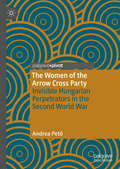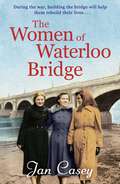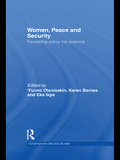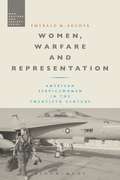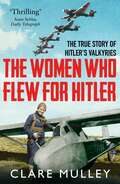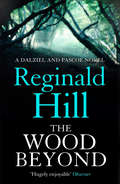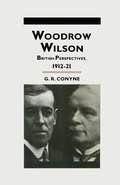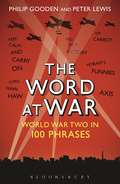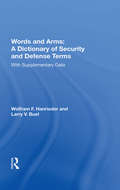- Table View
- List View
Women of Steel: The Feisty Factory Sisters Who Helped Win the War
by Michelle RawlinsTrue stories of love and loss during WWII, from the tough Northern women who kept the foundry fires burning.When war broke out, the young women of Sheffield had their carefree lives turned upside down. With their sweethearts being sent away to fight, they had no choice but to step into the men's shoes and become the backbone of the city's steel industry. Through hard toil and companionship, they vowed to keep the foundry fires burning and ensured that soldiers had the weapons, planes and ships needed to secure victory over Hitler.When the men returned from the front in 1945, many of these women tragically found themselves discarded 'like yesterday's fish and chip wrappers'. But decades later, a grassroots campaign spearheaded by the elderly Women of Steel finally brought their remarkable story to light.Women of Steel is the last chance to hear these unsung heroines' voices, as they share first-hand how a group of plucky young women rallied together to win the war for Britain.
The Women of the Arrow Cross Party: Invisible Hungarian Perpetrators in the Second World War
by Andrea PetőThis book analyses the actions, background, connections and the eventual trials of Hungarian female perpetrators in the Second World War through the concept of invisibility. It examines why and how far-right women in general and among them several Second World War perpetrators were made invisible by their fellow Arrow Cross Party members in the 1930s and during the war (1939-1945), and later by the Hungarian people’s tribunals responsible for the purge of those guilty of war crimes (1945-1949). It argues that because of their ‘invisibilization’ the legacy of these women could remain alive throughout the years of state socialism and that, furthermore, this legacy has actively contributed to the recent insurgence of far-right politics in Hungary. This book therefore analyses how the invisibility of Second World War perpetrators is connected to twenty-first century memory politics and the present-day resurgence of far-right movements.
The Women of Waterloo Bridge: the heart-wrenching WW2 saga of 2020
by Jan CaseyLondon, 1940. After her fiancé breaks off their engagement, Evelyn decides to do her part for the war effort by signing up for construction work on Waterloo Bridge. Enjoying the physical work and her newfound purpose, she begins to realise that there could be so much more to her life than anything she'd ever dared to dream of. Grieving after her little boy dies in an air raid, Gwen is completely lost when her husband sends their younger children to the countryside for safety. Enlisting as a construction worker, she is partnered with cheerful Evelyn. Despite Gwen's initial reticence, the two women strike up a heartwarming friendship – but will it be enough to save Gwen from her sorrow? Musical prodigy Joan's life has always been dictated by her controlling mother. When an affair nearly ends in scandal, Joan finally takes her life into her own hands. Determined never to touch a violin again, she soon finds work at Waterloo Bridge. Yet there are other troubles for her to overcome... For these three women, only one thing is certain: the Second World War will change their lives forever. A heart-wrenching new WW2 saga for fans of Jenny Holmes and Soraya M. Lane.
Women, Peace and Security: Translating Policy into Practice (Contemporary Security Studies)
by ’Funmi OlonisakinThis book provides a critical assessment of the impact of UN Resolution 1325 by examining the effect of peacebuilding missions on increasing gender equality within conflict-affected countries. UN Resolution 1325 was adopted in October 2000, and was the first time that the security concerns of women in situations of armed conflict and their role in peacebuilding was placed on the agenda of the UN Security Council. It was an important step forward in terms of bringing women’s rights and gender equality to bear in the UN’s peace and security agenda. More than a decade after the adoption of this Resolution, its practical reality is yet to be substantially felt on the ground in the very societies and regions where women remain disproportionately affected by armed conflict and grossly under-represented in peace processes. This realization, in part, led to the adoption in 2008 and 2009 of three other Security Council Resolutions, on sexual violence in conflict, violence against women, and for the development of indicators to measure progress in addressing women, peace and security issues. The book draws together the findings from eight countries and four regional contexts to provide guidance on how the impact of Resolution 1325 can be measured, and how peacekeeping operations could improve their capacity to effectively engender security. This book will be of much interest to students of peacebuilding, gender studies, the United Nations, international security and IR in general.
Women, Peace and Security: Translating Policy into Practice (Contemporary Security Studies)
by Funmi Olonisakin Karen Barnes Eka IkpeThis book provides a critical assessment of the impact of UN Resolution 1325 by examining the effect of peacebuilding missions on increasing gender equality within conflict-affected countries. UN Resolution 1325 was adopted in October 2000, and was the first time that the security concerns of women in situations of armed conflict and their role in peacebuilding was placed on the agenda of the UN Security Council. It was an important step forward in terms of bringing women’s rights and gender equality to bear in the UN’s peace and security agenda. More than a decade after the adoption of this Resolution, its practical reality is yet to be substantially felt on the ground in the very societies and regions where women remain disproportionately affected by armed conflict and grossly under-represented in peace processes. This realization, in part, led to the adoption in 2008 and 2009 of three other Security Council Resolutions, on sexual violence in conflict, violence against women, and for the development of indicators to measure progress in addressing women, peace and security issues. The book draws together the findings from eight countries and four regional contexts to provide guidance on how the impact of Resolution 1325 can be measured, and how peacekeeping operations could improve their capacity to effectively engender security. This book will be of much interest to students of peacebuilding, gender studies, the United Nations, international security and IR in general.
Women, Sexuality and War
by P. GoodmanThis book examines women's experiences in Britain during the Second World War, drawing on women's own memories and archival sources. It explores the myths and silences surrounding women's contribution to the war effort. Part of the text is devoted to women's experience of paid employment and how their sexuality became a contentious workplace issue. This theme is continued in the accounting for the sexuality of women on other spaces and places and how women re-negotiated their femininity, and thus their own 'war experiences'.
Women, Warfare and Representation: American Servicewomen in the Twentieth Century (War, Culture and Society)
by Emerald M. ArcherWomen, Warfare and Representation considers the various ways the American servicewoman has been represented throughout the 20th century and how those representations impact the roles she is permitted to inhabit. While women have a relatively short history in the American military, the last century shows an evolution of women's direct participation in war despite the need to overcome societal sex-role expectations. The primary focus is on the American case, but Emerald Archer also introduces a comparative element, showing how women's integration in the military differs in other countries, including Great Britain, Canada and Israel. Adopting an interdisciplinary approach, the book draws on military history, theory and social psychology to offer a more complete and integrated history of women in the military and their representation in society.
Women, Warfare and Representation: American Servicewomen in the Twentieth Century (War, Culture and Society)
by Emerald M. ArcherWomen, Warfare and Representation considers the various ways the American servicewoman has been represented throughout the 20th century and how those representations impact the roles she is permitted to inhabit. While women have a relatively short history in the American military, the last century shows an evolution of women's direct participation in war despite the need to overcome societal sex-role expectations. The primary focus is on the American case, but Emerald Archer also introduces a comparative element, showing how women's integration in the military differs in other countries, including Great Britain, Canada and Israel. Adopting an interdisciplinary approach, the book draws on military history, theory and social psychology to offer a more complete and integrated history of women in the military and their representation in society.
The Women Who Flew for Hitler: The True Story of Hitler's Valkyries
by Clare MulleyHanna Reitsch and Melitta von Stauffenberg were talented, courageous and strikingly attractive women who fought convention to make their names in the male-dominated field of flight in 1930s Germany. With the war, both became pioneering test pilots and both were awarded the Iron Cross for service to the Third Reich. But they could not have been more different and neither woman had a good word to say for the other.Hanna was middle-class, vivacious and distinctly Aryan, while the darker, more self-effacing Melitta, came from an aristocratic Prussian family. Both were driven by deeply held convictions about honour and patriotism but ultimately while Hanna tried to save Hitler's life, begging him to let her fly him to safety in April 1945, Melitta covertly supported the most famous attempt to assassinate the Führer. Their interwoven lives provide a vivid insight into Nazi Germany and its attitudes to women, class and race.Acclaimed biographer Clare Mulley gets under the skin of these two distinctive and unconventional women, giving a full - and as yet largely unknown - account of their contrasting yet strangely parallel lives, against a changing backdrop of the 1936 Olympics, the Eastern Front, the Berlin Air Club, and Hitler's bunker. Told with brio and great narrative flair, The Women Who Flew for Hitler is an extraordinary true story, with all the excitement and colour of the best fiction.
The Women Who Lived For Danger: Behind Enemy Lines During Wwii
by Marcus BinneyIn World War II, 37 women were dropped in occupied France to work as Special Operations Executive agents and 'set Europe ablaze'. 13 never returned. They were executed in Hitler's concentration camps. This is the fascinating story of eight of those female agents, all striking beauties (despite the need to be inconspicuous), all from civilian life, who were warned of the likelihood of arrest, torture and a brutal death before they volunteered. None demurred. These young women were given months of arduous fitness, gun, explosives, endurance and code training before parachuting into occupied territory. But Women Who Lived for Danger also contains eight very personal tales. Why did these women volunteer? Where did they come from? Marcus Binney tells of a life of Resistance work and uncover operations, clandestine activities and even armed combat, and a constant fear of discovery. But above this book tells of extreme bravery and devotion to duty.
The Women's Land Army in First World War Britain
by B. WhiteBetween 1917 and 1919 women enlisted in the Women's Land Army, a national organisation with the task of increasing domestic food production. Behind the scenes organisers laboured to not only recruit an army of women workers, but to also dispel public fears that Britain's Land Girls would be defeminized and devalued by their wartime experiences.
Women’s War: Fighting and Surviving the American Civil War
by Stephanie McCurryThe Civil War is remembered as a war of brother against brother, with women standing innocently on the sidelines. But battlefield realities soon challenged this simplistic understanding of women’s place in war. Stephanie McCurry shows that women were indispensable to the unfolding of the Civil War, as they have been—and continue to be—in all wars.
The Women's War of 1929: Gender and Violence in Colonial Nigeria
by Marc Matera Misty L. Bastian S. Kingsley Kent Susan Kingsley KentIn 1929, tens of thousands of south eastern Nigerian women rose up against British authority in what is known as the Women's War. This book brings togther, for the first time, the multiple perspectives of the war's colonized and colonial participants and examines its various actions within a single, gendered analytical frame.
The Wonder of War on Land (The World At War)
by Francis Rolt-WheelerFrancis Rolt-Wheeler (1876 - 1960) was born Francis William Wheeler in Forest Hills, England. He lived with his family, in England, until some time before 1901. He crossed the Atlantic where he became a naturalised US citizen in 1903, working as a journalist. Starting around 1906, Wheeler made a name for himself -- as Francis Rolt-Wheeler -- as a writer of books, mostly for boys, like The Boy with the United States Survey and The Boy with the US Trappers. He also published a 10 volume Science-History of the Universe, books for children with topics ranging from Aztecs to dinosaurs to Thomas Alva Edison, a series of books on aspects of the first world war, and some poetry and drama. Francis Rolt-Wheeler remained in the US until the late 1920, and his reputation as a writer of popular boy's material continued to wax through the 1920s. He was traveling globally quite a bit during this period and left the US for the Middle East, where he began his second career as an occultist. The Rolt-Wheeler handle was used by both Francis and his sister Ethel, a poet, writer, reincarnationist and Fellow of the Theosophical Society.
The Wood Beyond (Dalziel & Pascoe #14)
by Reginald Hill‘Hill’s wit is the constant, ironic foil to his vision, and to call this a mere crime novel is to say Everest is a nice little hill’ Frances Hegarty, Mail on Sunday
Woodrow Wilson: British Perspectives, 1912–21 (Studies in Military and Strategic History)
by G.R. ConyneThis is a narrative study of British diplomatic perceptions of Woodrow Wilson during his presidential campaign and presidency. Using archival material not previously explored for this purpose, George Conyne is able to challenge the conventional view of British reactions to Wilson and American policy at the Paris Peace Conference. He casts fresh light on the sources and the consequences of their image of the president of the United States.
Woodrow Wilson: The First World War and Modern Internationalism (Seminar Studies)
by Michael R. CudeThis volume contributes to the Routledge Seminar Studies history series by providing a concise narrative overview of the ideas and foreign policy of Woodrow Wilson. It focuses on Wilson’s response to the First World War and his efforts to formulate a new international system, while also outlining Wilson’s policies toward different parts of the world. The book shows how Wilson shaped the direction of the 20th century in areas such as global governance, nationalism, decolonization, and international relations theory. In doing so, the book introduces the reader to the many debates over Wilsonian foreign policy. With a target audience of college undergraduates and non-experts, readers will gain a better understanding of Wilson’s vision for the world, his administration’s approaches to foreign policy, particularly during the First World War, and the global impact of his program.
Woodrow Wilson: The First World War and Modern Internationalism (Seminar Studies)
by Michael R. CudeThis volume contributes to the Routledge Seminar Studies history series by providing a concise narrative overview of the ideas and foreign policy of Woodrow Wilson. It focuses on Wilson’s response to the First World War and his efforts to formulate a new international system, while also outlining Wilson’s policies toward different parts of the world. The book shows how Wilson shaped the direction of the 20th century in areas such as global governance, nationalism, decolonization, and international relations theory. In doing so, the book introduces the reader to the many debates over Wilsonian foreign policy. With a target audience of college undergraduates and non-experts, readers will gain a better understanding of Wilson’s vision for the world, his administration’s approaches to foreign policy, particularly during the First World War, and the global impact of his program.
Woodrow Wilson and the World War: A Chronicle Of Our Own Times (The World At War)
by Charles SeymourThis book was written right after the "Great War" it is a fantastic historical image of how contemporaries viewed the war, its causes, results, and how Woodrow Wilson managed and used it to further his ideological goal of Collective Security. It really is a great contemporary look of the situations surrounding the United States and World War I. It also has some previews of future prominent Americans such as Herbert Hoover and Franklin Roosevelt, before they were Presidents. (Excerpt from Goodreads)
The Woolworths Girls (Woolworths #1)
by Elaine EverestCan romance blossom in times of trouble?It's 1938 and as the threat of war hangs over the country, Sarah Caselton is preparing for her new job at Woolworths. Before long, she forms a tight bond with two of her colleagues: the glamorous Maisie and shy Freda. The trio couldn't be more different, but they immediately form a close-knit friendship, sharing their hopes and dreams for the future. Sarah soon falls into the rhythm of her new position, enjoying the social events hosted by Woolies and her blossoming romance with young assistant manager, Alan. But with the threat of war clouding the horizon, the young men and women of Woolworths realize that there are bigger battles ahead. It's a dangerous time for the nation, and an even more perilous time to fall in love . . .Elaine Everest's The Woolworths Girls is followed by the festive sequel, Christmas at Woolworths.
The Woolworths Girl's Promise: Love, drama and tragedy converge as the Woolworths saga returns...
by Elaine EverestThe Woolworth Girl’s Promise is the heart warming eighth novel in Elaine Everest’s bestselling Woolworths series that follows the turbulent life of a much-loved Woolworths girl.After losing her beloved fiancé at Ypres in 1917, seventeen-year-old Elizabeth Billington faces a lonely future estranged from her upper-class parents due to her association with Charlie Sayers and his working-class family. No longer able to live under her parent’s roof she is taken in by Charlie’s father, escaping the suffocating demands of her parents.Betty soon learns all too well about the realities of life after an accident at the Woolwich Arsenal munitions works. Spotting an advertisement for a nearby job at Woolworths, Betty starts on a new and thrilling journey starting at the bottom of the employment ladder in the well-known store.Her work journey leads her to Ramsgate in Kent to work in a newly built store and with it the chance of marriage, but can she ever forget Charlie and the promise she made to him…?Read this exciting early chapter in the life of well-known Betty Billington and follow her journey before she arrives at the Erith store and meets fellow Woolworths Girls in 1938 as war is again on the horizon . . .
The Word at War: World War Two in 100 Phrases
by Philip Gooden Peter LewisWar words have embedded themselves in our collective psyche; British politicians are fond of invoking the 'Dunkirk spirit' whenever the country is faced with major crisis or even minor adversity, and Roosevelt's famous description of Pearl Harbor as 'a date which will live in infamy' was echoed by many US commentators after the 9/11 attacks. So far, so familiar. Or is it? How many of us know, for instance, that 'Keep Calm and Carry On', far from achieving its morale-boosting aim, was considered at the time to be deeply patronizing by the people it was directed at, and so had only limited distribution? The Word at War explores 100 phrases spawned and popularized in the lead-up and during the conflict of World War Two. Substantial essays explore and explain the derivations of, and the stories behind, popular terms and phraseology of the period, including wartime speeches (and the words of Churchill, Hitler and FDR); service slang; national stereotypes; food and drink; and codewords.
The Word at War: World War Two in 100 Phrases
by Philip Gooden Peter LewisWar words have embedded themselves in our collective psyche; British politicians are fond of invoking the 'Dunkirk spirit' whenever the country is faced with major crisis or even minor adversity, and Roosevelt's famous description of Pearl Harbor as 'a date which will live in infamy' was echoed by many US commentators after the 9/11 attacks. So far, so familiar. Or is it? How many of us know, for instance, that 'Keep Calm and Carry On', far from achieving its morale-boosting aim, was considered at the time to be deeply patronizing by the people it was directed at, and so had only limited distribution? The Word at War explores 100 phrases spawned and popularized in the lead-up and during the conflict of World War Two. Substantial essays explore and explain the derivations of, and the stories behind, popular terms and phraseology of the period, including wartime speeches (and the words of Churchill, Hitler and FDR); service slang; national stereotypes; food and drink; and codewords.
Words And Arms: With Supplementary Data
by Wolfram F HanriederThis comprehensive dictionary of terms frequently used in discussions of national security and defense policy contains approximately 800 entries on weapons systems, strategy concepts, military organization, and related items. Part 2 presents a more extensive treatment of such concepts as strategic force doctrine and deployment, Soviet and U.S. poli
Words And Arms: With Supplementary Data
by Wolfram F HanriederThis comprehensive dictionary of terms frequently used in discussions of national security and defense policy contains approximately 800 entries on weapons systems, strategy concepts, military organization, and related items. Part 2 presents a more extensive treatment of such concepts as strategic force doctrine and deployment, Soviet and U.S. poli

